Disclosure: Meeple Mountain received a free copy of this product in exchange for an honest, unbiased review. This review is not intended to be an endorsement.
Imagination Is the Only Weapon In the War With Reality
There are some bad jobs in literature: Defense of the Dark Arts teacher in J. K. Rowling’s Harry Potter series, chimney sweep’ apprentice in Tom M. Franklin’s The Pterrible Pteranodon, and the pickpockets in Dickens’ Oliver Twist to name but a few.
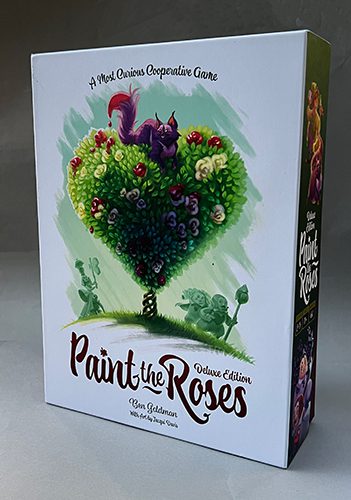
Then there’s being a gardener in The Red Queen’s garden in Lewis Carrol’s Alice in Wonderland. You know, the ones who had to paint the roses to the Red Queen’s ever-changing whims and, if they got the colors wrong, it was off with their heads.
Guess which one is now a board game?
Paint the Roses, the latest in a series of games set in the Alice in Wonderlandverse, is a deduction game where players will try to guess The Red Queen’s latest gardening whim. If you can completely fill in the garden on your last turn, you’ve escaped her axe and win the game.
Let’s get this to the table so you can see how Paint the Roses plays.
The Best Way to Explain It Is to Do It
Set up the board in easy reach of all players. Find the starting tiles (they’ll have a dark green border) and match their numbers with the numbers on the board. These will be your helpful starting tiles.
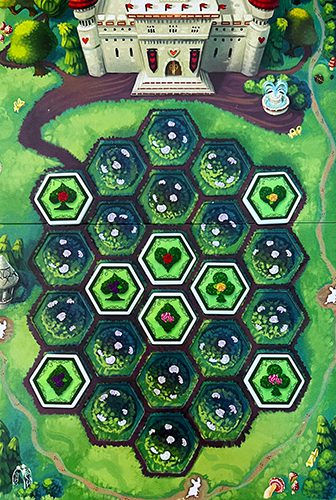
Mix all the other tiles in the bag and draw four at random to be placed in the Greenhouse.

Shuffle the three decks of cards separately and place them near the board. There are no restrictions as to how many players can take a Medium or Hard card, but only one player can have an Easy card.
Curiouser and Curiouser!
These cards represent the Red Queen’s whims regarding how she wants her garden arranged.

The cards work as follows:
- Easy cards match color to color.
- Medium cards match either color to color or hedge shape to hedge shape.
- Hard cards match either color to color or shape to shape or color to shape.
At the start of the game, all players will draw a card and examine it, keeping it a secret from their teammates.
The first player will then choose one of the four tiles in the Greenhouse—featuring a combination of a hedge shape (spade, heart, diamond, club) and a color (red, pink, yellow, purple)—and place it adjacent to another tile on the board.
Ideally, you’re looking to place your tile such that it meets only one possible condition—an idea that’s harder than it may seem.

Here, the tile with the spade-shaped hedge and the red rose has been placed adjacent to two tiles: another spade hedge with a red rose and a heart-shaped hedge with a red rose. The player who placed this tile has placed two cubes on the tile to indicate that the tile they placed contains two matches with the adjacent tiles.
That, however, doesn’t make for much of a game, does it? This example is really only possible with an Easy card (color to color) and only one player at a time can have an Easy card. Everyone else needs to choose either a Medium or a Hard card. Let’s take a look at each of those then.
Here’s a Medium card with a tile placed in the same position on the board. Remember, medium cards can either be color to color or shape to shape.
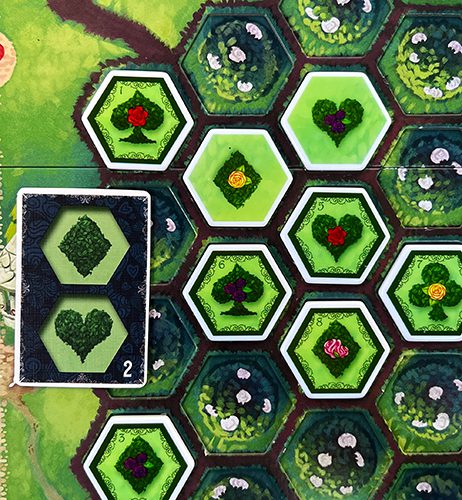
The card shows a diamond-shaped hedge and a heart-shaped hedge. This player has chosen a tile with a diamond-shaped hedge with a yellow rose. Since the diamond hedge on the tile matches their card and is adjacent to two tiles that have heart-shaped hedges, they place two of their cubes on the tile.
However, this is where the game gets interesting. Do those two cubes mean a match between the diamond and the hearts? Or the diamond and the spade? What about the yellow rose and the two red roses? Or the two purple roses?
Hard cards complicate things even further because they can be color to color; shape to shape; or color to shape.

In this example, the player has drawn a Hard card that features a heart-shaped hedge and purple roses. Placing a diamond-shaped hedge with a purple rose on the board next to two heart-shaped hedges, they also place two cubes on the tile.
The other players look at the two cubes and determine this could mean the card could be a match between diamond and diamond; diamond and heart; purple and purple; purple and pink; diamond and pink; diamond and purple; purple and heart.
Given the possible permutations, why would anyone want to choose anything other than an Easy or Medium card?
“How Do You Like the Queen?” Said the Cat In a Low Voice.
“Not At All,” Said Alice: “She’s So Extremely—” Just Then She Noticed That the Queen Was Close Behind Her, Listening: So She Went On “—Likely to Win, That It’s Hardly Worth While Finishing the Game.”
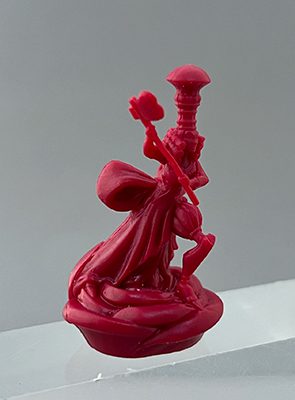
Well, there’s the small matter of The Red Queen, who would be just as happy to chop your head off as she would see you arrange her garden correctly.
At the end of each turn, two things will happen: players must make a guess and The Red Queen will move. As in, move closer to you with her axe raised.
Guessing is just that—making a guess as to what is on a player’s card. After that, depending whether the guess was correct or not, The Red Queen will move a little or a lot.
The Red Queen starts with a single red rose under her. This means for each correct guess she’ll only move one space closer. For each incorrect guess, she’ll move twice that number, or two spaces. As players move around the board, there are set spaces where, once you pass over them, The Red Queen acquires another rose. And another rose. Two roses means two spaces for a correct answer and four for an incorrect guess; three roses means three spaces for a correct guess and six for an incorrect guess.
In the lower left corner of each card is a number. This is the number of spaces you’ll move forward on a correct guess. With an Easy card you’ll move one or two spaces; Medium cards will move you ___ to ___ spaces; Hard cards will move you four to five spaces.
I Am Not Crazy; My Reality is Just Different From Yours
A few important caveats:
In a Two-Player Game
- You’ll have three opportunities in the game to not make a guess. The Red Queen will still move as if you guessed correctly.
In a Three-Plus Player Game
- When the active player places a tile on the board, all players look to see if the placed tile and the surrounding tiles match what is on their card. If so, they place their cubes on the tile as well.
- While a guess must be made at the end of each turn, that guess can be for any player’s card. The guess does not need to be for the active player’s card.
- After a successful guess, players may also choose to guess another player’s card. If they do so, The Red Queen only moves once players either choose to stop guessing or when they make an incorrect guess.
The speed at which The Red Queen moves will dictate the type of card you choose, with Easy cards being quickly overlooked for the increased movement of a Medium or Hard card. In most games I’ve played, our comfortable early lead has been all but eliminated after only a few incorrect guesses once The Red Queen stands on additional roses.
We’re All Mad Here
The review copy NorthStar Games sent me is the deluxe edition which comes with the Escape the Castle expansion. Just take a look at the artwork:
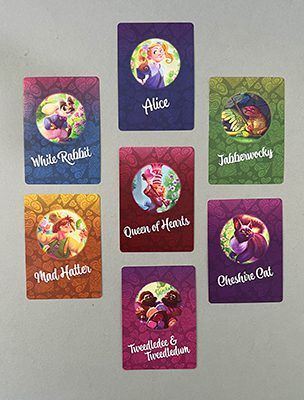
As if Paint the Roses wasn’t hard enough (and it is!) players now need to gain the five keys necessary to escape The Red Queen’s garden. Each of the six modules starts with one Red Queen card chosen at random that gives her additional powers and the card(s) of your chosen module. Modules may have you changing the starting board set up, reward you with a key for placing tiles in specific arrangements, or meeting certain objectives.
Not All Who Wander Are Lost

Paint the Roses comes in either a standard version or the deluxe edition. The standard (retail) edition comes with a flat board and cardboard tiles. The deluxe edition comes with a two-layer board and bakelite tiles that sit easily in the recessed areas in the garden. Oh, and along with those six additional modules, it comes with this impressive and highly functional organizer.
This organizer has always elicited Oohs and Aahs when people first see it, drawing them right into the game before it even starts.
In the box sits another organizer for all the Escape the Castle cards, as well as the other items used in the game.
Very nicely done.
Feed Your Head
While Paint the Roses is considered a deduction game, I feel the group guessing aspect of the game makes it a social deduction game—and If you’ve read my reviews of Whitehall Mysteries, On Circus Grounds, or Rear Window, you’ll know that I’m a big fan of social deduction games. There’s something about the way they draw players into the game, generating discussions that engage all the players on each turn that make them some of my favorite gaming experiences.
After my first play of Paint the Roses I was a little put off by what I perceived to be the imperfect information the game insists you play with. Color to color was fine, but the Medium and Hard cards presented too many choices with no clear idea as to which choice was correct. This was, I think, more of an issue when playing the game with two players. Having the consequences of a wrong guess, along with the possibility of losing the game, resting solely with my guess, didn’t sit all that well with me.
Playing with three and four players made each guess a communal decision, thus taking the pressure off me alone. As well, the addition of—or lack of—cubes played by other players on each turn gave additional information about what might be on their cards.
That lack of cubes is an important part of the game, and one that players often don’t fully appreciate until they’ve played the game several times. When playing with more than two players, on each turn you’re not only getting information about the card the active player is holding, but also the cards each other player is holding.
If the active player places, say, two cubes, on the tile they place, that gives you a lot of information about their card. If the other players don’t place a cube on the tile, it also tells you a lot about their cards. That information (“It’s not this color or this shape.”) only builds with each subsequent turn—and helps mitigate the feeling I initially had of dealing with too much imperfect information.
I’ve played Paint the Roses with three different groups of people. Each was drawn in, initially, by the theme and then by the puzzle-y aspect of the game. One reason I like the game so much is that ability to hook people so quickly with both aspects of the game, playing as the active player and then as part of the group guessing someone’s card.
I’ve found that Paint the Roses is a difficult game to win, but it rarely feels unwinnable. I have lost the game with each of the groups I played with. Those games were often close, with The Red Queen lopping our collective heads off with only three or four tiles left to complete the board. What’s most telling, though, is that despite losing, everyone I’ve played it with has been eager to play it again. And again.
Oh, and the one time we won it felt great.
Paint the Roses is going to stay in my collection for a long time. It’s challenging, fun, and has a tension that only increases the closer you get to winning. If the best games create interesting choices and produce enjoyable memories, it certainly fits the bill.












Add Comment